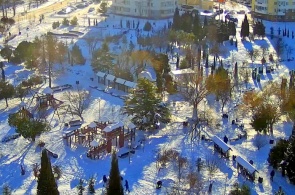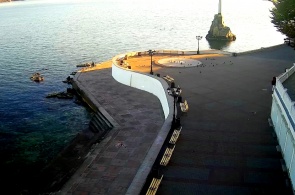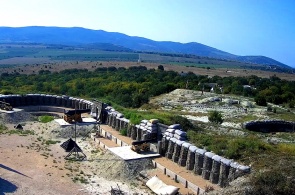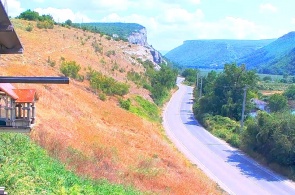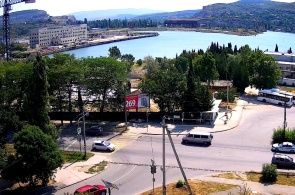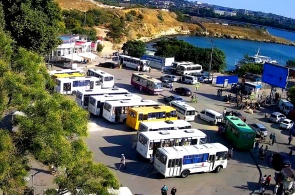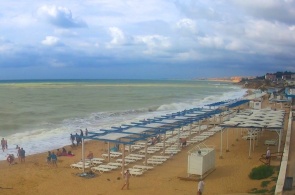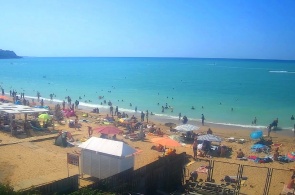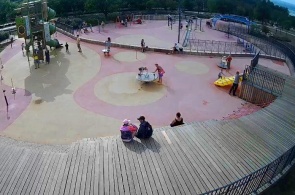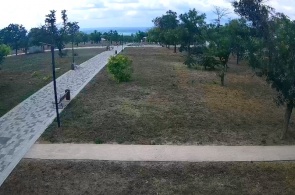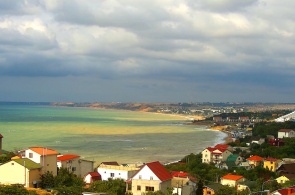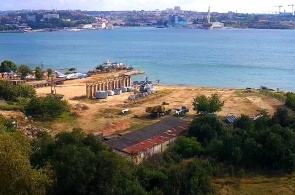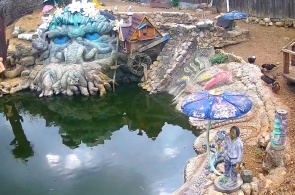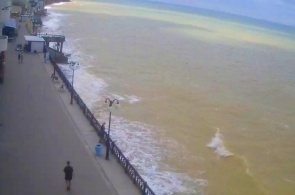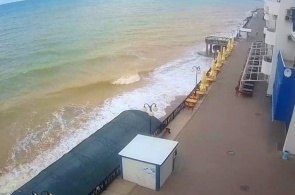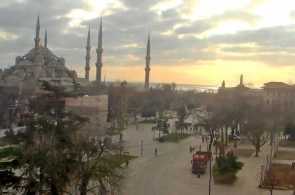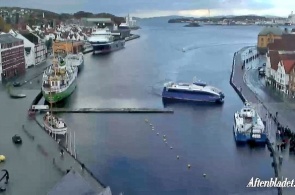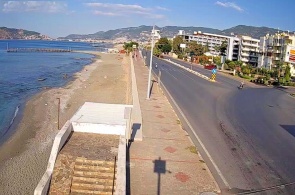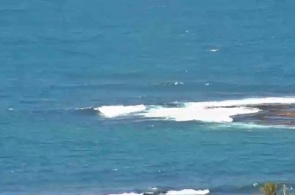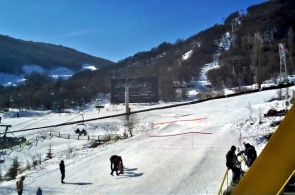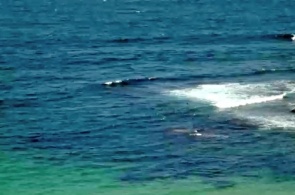In a small cozy bay, at a distance of 12 km south of Sevastopol, there is the town of Balaklava, which, despite its size, has an outstanding history and multifaceted cultural heritage.
At different times, Greeks, Genoese, Turks lived in Balaklava. According to one of the versions, the city owes its name to the Turkish language, in translation from which the toponym means "fish nest".
Balaklava became a resort town relatively recently - at the beginning of the last century. Tourists love to come here for amazing views, similar to the European Riviera, as well as unique attractions.
One of the most popular museums in Balaklava is the Object 825 GTS complex. It was formed from a declassified military facility that existed here until the end of the last century. There was an underground base for Soviet submarines, which could not be seen from the sea due to the peculiarities of the local landscape. There was also a secret repair base.
The size of the complex made it possible to fit 7-9 large submarines in it at once. But in 1994 the last submarine was removed from here, and later the object was turned into a museum exhibition.
Another unique object appeared on the territory of Balaklava Bay much earlier. So, in the middle of the XIV century, a Genoese fortress was built here. The first building existed for a relatively short time and was destroyed almost to the ground by the Horde troops. But after the Genoese regained Mount Castron, the fortification was rebuilt.
After 100 years, the Theodorites came here, then the Genoese returned again, followed by the Ottoman Turks. After all these events, only a few dilapidated towers and walls have survived to our time. However, this object is considered a historical monument and is also often featured as a background for photos.
By the way, Balaklava Bay itself has an eventful history. Alternately, it was owned by the Greeks, Romans, Genoese, Turks. This is because the geographical features of this area made it possible to perfectly moor ships. The shape of the bay does not allow strong winds to penetrate into its depths, and the rocks make it invisible from the sea. At the same time, the depth of the formation is 17 meters, and the width is only 200-400. Such parameters make it possible to place a large number of ships and remain invisible to a potential enemy.
By the way, according to some sources, the bay of Listrigones mentioned in Homer's "Odyssey" is exactly Balaklava.
At different times, Greeks, Genoese, Turks lived in Balaklava. According to one of the versions, the city owes its name to the Turkish language, in translation from which the toponym means "fish nest".
Balaklava became a resort town relatively recently - at the beginning of the last century. Tourists love to come here for amazing views, similar to the European Riviera, as well as unique attractions.
One of the most popular museums in Balaklava is the Object 825 GTS complex. It was formed from a declassified military facility that existed here until the end of the last century. There was an underground base for Soviet submarines, which could not be seen from the sea due to the peculiarities of the local landscape. There was also a secret repair base.
The size of the complex made it possible to fit 7-9 large submarines in it at once. But in 1994 the last submarine was removed from here, and later the object was turned into a museum exhibition.
Another unique object appeared on the territory of Balaklava Bay much earlier. So, in the middle of the XIV century, a Genoese fortress was built here. The first building existed for a relatively short time and was destroyed almost to the ground by the Horde troops. But after the Genoese regained Mount Castron, the fortification was rebuilt.
After 100 years, the Theodorites came here, then the Genoese returned again, followed by the Ottoman Turks. After all these events, only a few dilapidated towers and walls have survived to our time. However, this object is considered a historical monument and is also often featured as a background for photos.
By the way, Balaklava Bay itself has an eventful history. Alternately, it was owned by the Greeks, Romans, Genoese, Turks. This is because the geographical features of this area made it possible to perfectly moor ships. The shape of the bay does not allow strong winds to penetrate into its depths, and the rocks make it invisible from the sea. At the same time, the depth of the formation is 17 meters, and the width is only 200-400. Such parameters make it possible to place a large number of ships and remain invisible to a potential enemy.
By the way, according to some sources, the bay of Listrigones mentioned in Homer's "Odyssey" is exactly Balaklava.
More details
Camera overlooking the park of dinosaurs in Sevastopol (Crimea). The complex is located between Pavel Korchagin and Chelnokov streets, next to residential areas. On the territory of the park there are many models of prehistoric reptiles, a playground, a street gallery and many other interesting objects. What is happening can be observed in real time.
Sevastopol, Crimea
06.01.22
The camera is broadcasting from the Kornilov embankment (Sevastopol, Crimea). The lens captures a view of a winding promenade, furnished with benches and lanterns, a sundial, a monument to the Scuttled Ships. The broadcast is carried out in real time and promises a pleasant interactive walk to the warm coast of the Crimean peninsula.
Sevastopol, Crimea
08.09.21
The camera broadcasts a view of the Fedyukhiny Vysota living history park in the Balaklava district of Sevastopol. A picturesque panorama of the mountain range with vineyards and forest lands opens before your eyes. One of the sites of historical reconstruction with military attributes is visible in the foreground.
Sevastopol, Crimea
24.08.21
The webcam is located in the valley of the Belbek River (Crimea). The lens captures the roadway along Yaltinskaya street near the village of Tankovoye, surrounded by picturesque landscapes. In the background, mountain peaks and vineyards are visible. The broadcast is transmitted in HD quality with pleasant music in real time.
Sevastopol, Crimea
23.08.21
Camera with a view of Inkerman (Crimea). The overview covers a road fork at the 60th anniversary of October square. Public transport stops are nearby. In the background, part of the Inkerman Bay in the port area is visible. Broadcast in HD format is carried out in real time.
Sevastopol, Crimea
23.08.21
Webcam overlooking Zakharov Square near the Severnaya bus station in Sevastopol. The survey covers the building of the bus station with adjoining bus platforms, from which flights across Sevastopol and Crimea depart. Behind you can see the water area of the Severnaya Bay with ships passing through it. The broadcast is conducted online.
Sevastopol, Crimea
21.08.21
Camera number 1 on the Uchkuevka beach in Sevastopol (Republic of Crimea). The overview encompasses a wide line of sandy beach with shady awnings and cafes, as well as part of the promenade. Most of the image is occupied by the Black Sea. The broadcast is carried out in real time.
Sevastopol, Crimea
21.08.21
Webcam No. 2 is installed on the northern side of Sevastopol, overlooking the territory of the Uchkuevka beach. The survey covers the long and wide coastline of the sandy coast and the Black Sea. The beaches of Uchkuevka are considered the best in Sevastopol. The broadcast is conducted online.
Sevastopol, Crimea
21.08.21
Camera overlooking the playground in Uchkuevka park (Sevastopol, Crimea). The survey covers a semicircular territory, where there are many playgrounds for children of different ages. In the background, a vast green area and the sea are visible. You can watch what is happening in real time.
Sevastopol, Crimea
21.08.21
The webcam is located in the Uchkuevka park (Sevastopol). The overview covers a well-maintained central alley, young trees. The Black Sea strip is visible in the background. The park is a multifunctional cultural and entertainment complex that appeared on the northern side of the city in 2019. The broadcast is carried out in real time.
Sevastopol, Crimea
21.08.21
The device is located in Uchkuevka (Sevastopol, Crimea). The survey covers residential buildings, houses and hotels, as well as the coastline and the Sevastopol Bay. The broadcast is carried out in real time, therefore, if you wish, you can take an exciting virtual walk at any time of the year and from anywhere in the world. The HD video sequence is accompanied by pleasant music.
Sevastopol, Crimea
20.08.21
The webcam is installed in the Radiogorka microdistrict (Crimea, Sevastopol). The survey covers the coast of the Matyushenko Bay, the city pier "Radiogorka", the opposite coast of the Sevastopol Bay, as well as a complex of monuments to aviation technology. Fragments of the walls of the Mikhailovskaya battery are visible on the left. The broadcast is carried out in real time.
Sevastopol, Crimea
20.08.21
Webcam with HD view of the pond of the eco-park "Lukomorye" (Sevastopol, Crimea). An artificial reservoir, decorated with sculptures and plants, enters the lens. The pond is inhabited by waterfowl. The park was founded in 1984, but it is interesting to visit it to this day, including taking a virtual walk online.
Sevastopol, Crimea
20.08.21
The camera is located in the village of Kacha (Sevastopol). The overview covers a landscaped embankment and a beach in the direction of Sevastopol. Most of the survey is occupied by the Black Sea. Anyone can take a virtual walk to the warm coast of Crimea, regardless of the season and location.
Sevastopol, Crimea
20.08.21
The camera is positioned on the territory of the tourist complex "Our Parus" in the resort village of Kacha (Sevastopol, Nakhimovsky district). The overview covers part of the embankment, the beach, as well as the building and the cafe of the complex. The highlight is the ability to see the Black Sea in real time with sound.
Sevastopol, Crimea
20.08.21
popular camerasshow all
Sultanahmet or Blue mosque is a work of art of Turkish-Islamic architecture. Its construction began in 1609, the construction work took seven years to a 19-year-old Sultan. The name of the mosque was, due to its interesting and unique finish.
Istanbul, Turkey
Stavanger, a town in the commune of Norway, located in the South-Western part of the country, on the Peninsula, rich in minerals. Tanager combines the influence of foreign organisations such as NATO and oil companies. The camera will shoot the harbour and the promenade of the city.
Stavanger, Norway
A webcam broadcasts the district of Tosmur - quiet location in the Eastern part of Alanya, located only five kilometres from the city centre. Its rural way of life and the beauty of untouched nature attract tourists.
Alanya, Turkey
Shark Island or in English of Shark island, located in the harbour city of Sydney, the suburb of Point Piper. The locals, the natives named the island Boambilly, which translated means Shark island. After all, this name is not casual, because it's mean and looks like a shark fin.
Sydney, Australia
The webcam is installed on site Alva. Tsaghkadzor ski resort town in Armenia. Tsaghkadzor is a beautiful mountainous area among deciduous forests, with a pleasant winter climate, and clean fresh air. The highest point is 1800 meters. The truss type is a classic, divided into three.
Tsakhkadzor, Armenia

